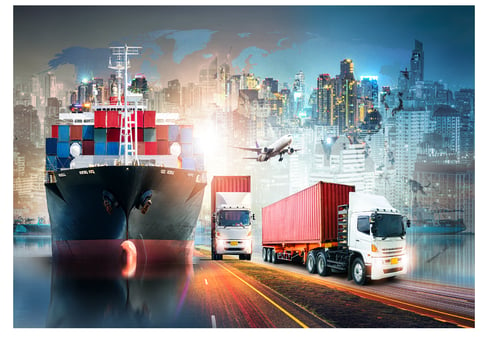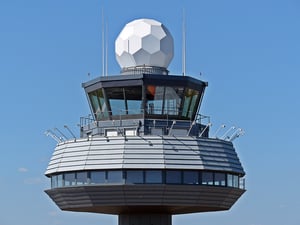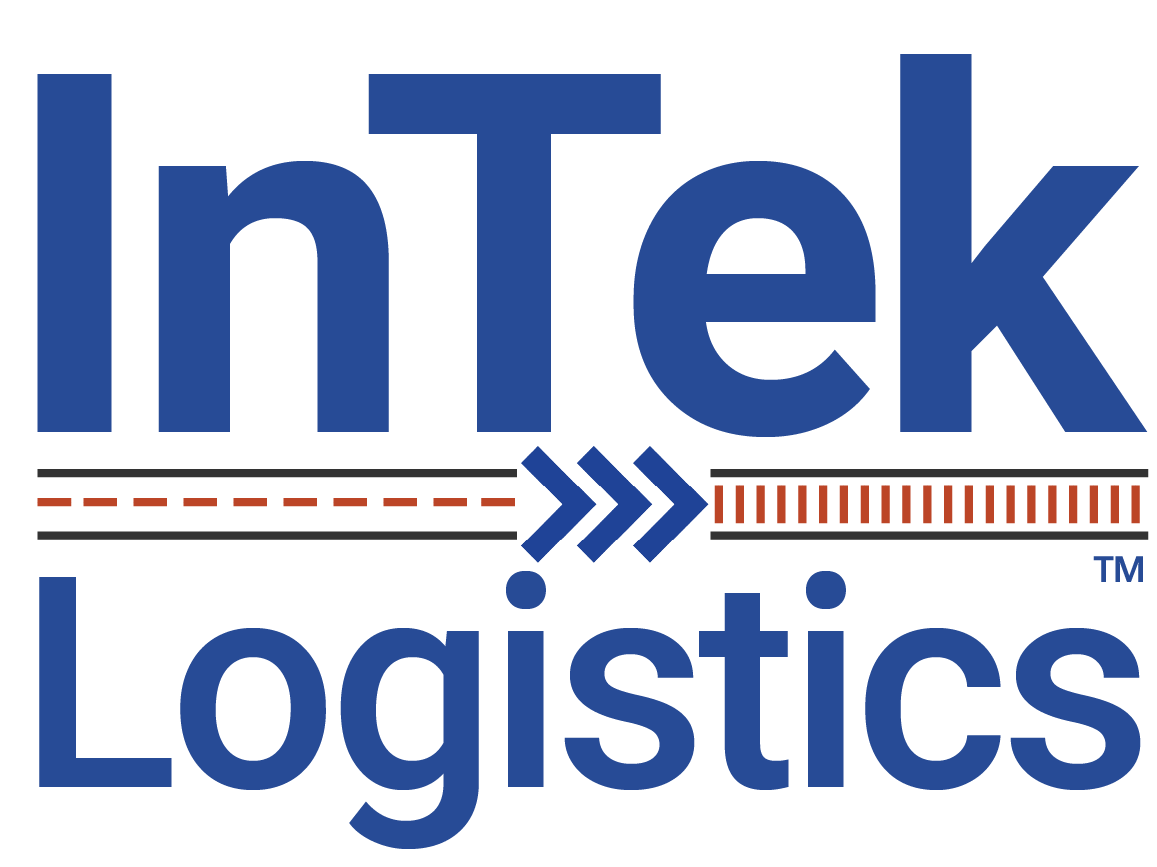
Chapters

The ability of a company to integrate and execute technology has increasingly become a critical aspect for its success.
Logistics and supply chain management teams have been the beneficiary of increased technology investment as companies have come to realize that building a stronger tomorrow comes from supply chain excellence. The technology continues to become increasingly more sophisticated and important for efficiency, cost, service and building a competitive advantage company.
The key issues the TMS addresses coming out of the box are:
- Ability to Find Freight Capacity Quickly
- Reduce Freight Transportation Costs
- Address Increasing Regulatory Issues
- Have a Software That is Easily Understood by Users
- Provide Transparency to the Logistics & Supply Chain Activities of a Company
From a logistics perspective, transportation management software (TMS) is the key component where most companies begin to move their company from a tactical to strategic perspective in its operations and corporate thinking.
Transportation management software implementation has changed the game. Not only has it changed the way freight gets from point A to point B, but it's also pushed logistics and supply chains as a way to drive a competitive advantage.
The 2018 and now the 2020 freight market capacity shortages had shippers across the US scrambling to find trucking capacity to move their freight at a fair price. With this event now in the rearview mirror, companies are preparing themselves so they do not go through that struggle again by moving their logistics teams off spreadsheets and outdated or internally developed freight systems. Because of this transition, the TMS adoption and growth between now and 2030 is expected even to surpass what was already a skyrocket exponential curve.
A big component driving the incredible growth is the surprising low adoption rates of TMS technology today, as a recent study by Gartner found:
- Companies Over $100 Million in Freight Spend - 50% Adoption of TMS
- Companies Between $25 Million - $100 Million - 25% Adoption of TMS
- Companies Under $25 Million in Freight Spend - Roughly 10% Adoption of TMS
Blending the numbers above would indicate that only 35% to 40% of logistics teams are using a TMS to operate their business. All said, there is plenty of runway ahead for shippers to drive significant improvement in their supply chain. As the numbers indicate, you do not want to be one of those lagging behind for numerous reasons.
A TMS is no longer a stand-alone internal piece of software that the freight department manages, but instead it is a connected system to both internal and external systems and databases to streamline and reduce the friction as product is converted from raw goods being delivered from its vendors to a final salable product sent to the end customer. As part of reducing the friction, the TMS provides transparency to the activities throughout the entire supply chain that only improves the customer experience.
Add to the customer experience and ability to better manage the flow of products through the supply chain, the top TMS systems connect into industry databases to improve not only daily operational work, but to also connect into the ever expanding databases that hold billions of dollars of fright spend by lane.
The importance of both cannot be oversold. By tapping into the market databases finance and logistics teams can truly optimize the company’s performance in the cost and capacity equation. No longer will the next freight request-for-quote (RFP) be a solve to equation to what the bottom line budget is to be or an arbitrary flat rate reduction, but instead operated based on what others are spending for the same freight lane.
Some companies have opted to decrease their software investment requirements and climb up the TMS curve quicker by employing a managed transportation service third party logistics company (3PL). These companies have game changing software that they leverage across multiple shippers to dramatically reduce costs and improve service across a single platform.
Companies not interested in the outsourced managed transportation services model have the option to purchase and implement a top tier cloud based TMS. The SaaS cloud TMS is a low-cost, high-value transportation service software option for both small and large companies. It allows them to pay for only what they use and to tap into industry best practices that are continuing to be added by the 100’s of thousands of users that log into these systems everyday.
Even with all the pluses a TMS can bring, there is always a potential of selecting the wrong TMS software or struggling through a TMS implementation if the system is not selected by a company.
With that said, the single biggest step in any TMS decision is selecting the system that will be the best fit for the shipper both now and into the future. A TMS implementation is a big project, so shippers should not shortchange what the future will bring for the. They do not want to find themselves going through a new TMS change or upgrade every 3 to 5 years. The “right fit” TMS should last a lifetime.
The problem for many companies face in their TMS selection process is the vast array of TMS software providers in the market to choose from. The process can be overwhelming and frustrating, which is why it is so important to put together a requirements document that weights each of the functional aspects from most to least important, the company needs at the front end of the process. That way, there is no confusion and the decision process is subjective in nature.
We recommend that you take the following things into account when going through the TMS selection process:.jpg?width=500&name=Transit%20(2).jpg)
- General Functionality
- Rating and Contracts
- Strategic and Tactical Planning
- Operational Planning and Execution
- Optimization Engine
- Dedicated Fleet Optimization with
- Non-Asset Requirements
- Reporting Visibility
- Web Portals
- Settlement
- Analytics
It is also a good idea to consider working with a trusted partner for your TMS implementation. Without a trusted partner details can slip through the cracks and create holes in the system will expose weakness. Just like with any business critical update or change it is important to have someone on hand to review things with a fine tooth comb and to monitor the TMS implementation and your progress.
As part of the process you will want to equip your team with adequate resources and a well tested training program that will help set you up for success. Consequences of not investing the time and resources upfront to properly test the system’s functionality and train your personnel will put the entire process behind the curve and have management questioning their decision. In summary, human capital is necessary to support the TMS from start to finish.
Even with the potential pitfalls that can come with a TMS, relying on Excel or outdated systems put your company at risk and limits its overall potential of driving a competitive advantage in the marketplace where the leaders of logistics and supply chain strategies are crushing it everyday.
With the proper tools and partner, the risks can easily be overcome. So, with the background information behind us, we invite readers to continue their TMS journey with significantly more detail on transportation management software and how to be successful with incorporating logistics technology within your company.

.jpg?width=250&height=324&name=TMS%20RFP%20Template%20Cover%20(1).jpg)
Transportation Management Software RFP Template
Download A Free Copy of our Transportation Management Software (TMS) RFP Template to kickstart your TMS buying process.
The template helps you organize the functional requirements your company is looking for in order to meet your logistics and supply chain goals, thus clarifying exactly what you'll need when searching for a solution.


The benefits of a TMS solution include more than savings on freight cost, they allow companies to simplify the flow of goods through their supply chain.
In the following section, we will introduce you to the must-haves of TMS software platforms that drive the highest savings and ROI for a company’s supply chain, but before jumping into the details, below is a quick overview of the typically cost savings components and ROI of a transportation management system:
Planning & Optimization
- 3%-12% saving opportunity
- Analyzing shipments, rates and constraints

Execution & Advanced Visibility
- 2%-5% savings opportunity
- Automated Execution Tasks and workflows
- Rate / Capacity / Routing Guide / Carrier Performance Management
Settlement
- 2%-5% saving opportunity
- Self-billing, freight audit and pay
Procurement
- 3%-10% saving opportunity
- Secure / Maintainable Durable Rates / Capacities
- Reduce Broker Dependencies
A transportation management system brings with it a great deal of functionality and benefits, so let us take a closer look at everything a TMS can do for a company’s logistics and supply chain tactics and strategy.
Focus on Industry Best Practices
Companies leading the market are implementing TMS software into their businesses quicker than ever, which has caused the TMS software market to grow exponentially. Companies are moving away from Microsoft Access and Excel, along with other less efficient and effective methods for moving their freight.
The days of relying on spreadsheets, phone calls and emails have long passed. There are simply too many moving parts in the shipping process and internal and external stakeholders demand and deserve more. To keep up, TMS software platforms have expanded their scope over the past decade. Today TMSs are more than freight management platforms, they are fully connected systems for all product movement that is accessible to everyone involved for all their management needs.
TMS industry best practices require companies to incorporate the software with all the systems involved. This allows them to provide key information to their customers from the point the goods are purchased to the point the customer takes delivery of the final product.
Once in place, the TMS will monitor, report and capture data so you can analyze how to improve your tactics and strategy for better performance in the future. Amazon’s Founder and CEO Jeff Bezos, calls and compares this process of ever-evolving improvement the "fly-wheel effect" where the process starts slow, but as more people touch the wheel to push it forward it picks up speed along the way and takes on a life of its own.
Improve Operational Efficiencies
Full transparency of all freight movements for internal and external stakeholders is part of a successful TMS software.
Again, the value a TMS brings is more than managing freight, it also brings the stakeholders together within the supply chain to remove barriers and reduce friction in the process.
While we keep pushing the idea that a TMS is more than freight, we do understand that many of you are looking to figure out a better mousetrap to drive cost savings and efficiencies in your department, which is absolutely what a TMS can do.
The TMS drives efficiencies in planning the most efficient freight routes, then automates the execution processes from shipment tender to final delivery.
It uses a waterfall method where the least cost to most cost contracted carrier is offered the freight. When a contract carrier is unavailable for the given load, the carrier management process automatically taps into the thousands of carriers available on the freight load boards and streamlines the onboarding process and managing their spot rates, charges, terms of shipment, certifications, and transit maps to ensure the freight capacity is found for the 100% of day’s shipping requirements.
Once the shipment is tendered out, the TMS takes over in helping the logistics team track and monitor the shipment through various methods and reports exceptions that are falling out of specifications to make an on-time pick-up and delivery. The way in which the TMS assists in this monitoring process is through its electronic integration or customized portal access for carriers to report their process along the way. While some carriers may not always update the shipment progress, their load will fall out of spec and an email or call will be made asking for a response. In this way, the freight operations team is managing the exception so to avoid as many last-minute fires as possible in the shipping progress.
Increase Customer Service
A good TMS software can enable benefits on the customer service side of the business as well. This is especially important in an economy where the retail customer base is becoming more and more demanding.
Track & Trace Shipments
TMS software tracks a shipment from tender to delivery. It does this because the implications of the decisions made throughout the process ultimately affect the transportation process and the satisfaction of the customer, whether internal or external. The tracking element of a TMS software provides consumers with 100% transparency throughout the shipment process.
While TMS has its origins in managing outbound freight, it is also a great tool to manage inbound freight. The management of inbound freight is often overlooked and undervalued, but when incorporated into the supply chain strategy brings the complete picture into focus and further gives the company opportunities to save on its freight and operating costs. When a company has visibility to all the inbound shipments it can better manage the inbound receiving dock activities and better plan and monitor its production processes. This is particularly important in a just-in-time (JIT) environment.
Connections with Industry and Operational Data Platforms
The modern-day TMS connects with the freight industry and logistics market analytic platforms. Freight industry platforms include load boards, insurance validation, operating authority validation, contract validation, rating platform, and enhanced visibility platform. These leading industry services increase the ability of logistics teams in being able to fill a freight load efficiently and safely with nothing more than a push of a button.
On the logistics market analysis side, there are numerous data warehouse consortiums that roll up billions of dollars of freight spend by capturing data by lane from various shippers and logistics companies across the US. The data is collected on an anonymous basis whereby buyers of the information cannot see what the carriers or the customers of the freight spend, but do see the actual spend on essentially every origin/destination point.
This information is not averages of averages, but actual lane-by-lane freight rate data that shippers and logistics companies can use to measure their performance against the market. The advent of these logistics data meccas has forever changed how companies can benchmark their freight spend against the best, worst and average in the lane to create and execute the most competitive RFP for their business.
Collection of Data

Analytics
It is important to note that while a TMS is an incredible tool for freight operations teams, it is also an incredible database of information to optimize the freight spend of an organization.
A TMS allows its users to perform what-if analysis for tactical and strategic decision support, along with being a great tool to for RFP management and execution. As mentioned in the previous section, connecting the TMS to the outside benchmark databases makes the RFP market-leading.
Because of the situational analysis, actual scenarios can be measured with actual results in the TMS itself quickly and easily. While this seems natural, for those shippers not operating a tier 1 TMS find themselves running averages of averages or cannot even get their hands on the actual data and volumes which raises the bar exponentially in optimizing the results that otherwise cannot be managed in an Excel spreadsheet.
Reporting
Today’s TMS software platforms have vastly improved standard and customized reporting, as well. Reporting can be run on a preset schedule, on an ad hoc basis, be provided through web portals or a combination of these methods.
The reports can be operation, customer service or financial oriented, and companies have the ability to decide what data to report on based on their specific KPIs. If need be, the information can also be sent to vendors and customers in a customized report that includes their logo and particular nomenclature.
Any way one looks at, either push, pull or ad hoc, the reporting that comes through the TMS will raise the logistics and supply chain bar in any organization.
Benchmarking
The days of spending tens of thousands of dollars and only getting a snippet of information or averages-of-averages are well behind us, although many organizations continue to use the largest consulting and logistics companies that charge upwards of $50,000 plus analytics. There are plenty of companies like InTek Freight & Logistics that can perform the analysis or the annual RFP at significantly less cost with the same or better effectiveness.
An effective TMS will bring together best-in-class benchmarking to put a company up against its competitors versus what is typically done with most companies. Benchmarks provide an opportunity for brokers to leverage better carrier rates and compare against others in terms of contract terms. Overall it gives perspective on who does it best and what companies can change for competitive advantage.
Technology Strategy, Design and Integration
The data compiled by TMS software is useful not only for day-to-day operations but also for helping companies evaluate long-term strategic direction. This software has changed the industry as optimization is now faster than ever, allowing companies to capitalize on additional pooling, consolidation and round trip opportunities. In short, all of the data the TMS collects is crucial to produce fly-wheel like effects on the improvement of all logistics and supply chain components.
Financial Planning and Strategy
One of the most important goals of a TMS is the overall reduction in the freight cost. This reduction, which comes through a variety of functions within the TMS. Since this goal typically the most important for more than half of TMS buyers, we will spend additional time unpacking the topic of savings and how it is attained through a TMS.
Freight Audit & Pay
The typical savings a TMS user will gain in the freight audit and payment process is between 2-5%.
Freight audit and pay is complicated because of the total number of transactions and pricing variations are required documentation. A TMS simplifies the process of auditing the rates against those assigned to the load at the tender and acceptance phase of the shipment process, along with validating the paperwork sent in by the carrier.
Some TMS systems, like InTek’s, also simplify the document management process whereby the documents associated with the shipment are collected at the time of audit and uploaded to each shipment once the rates are approved for payment. What makes this possible is the carrier’s invoice and back-up documents are sent into the TMS via an email from the carrier. The TMS identifies each piece of paperwork and scrapes off the required information to audit the bill through optical character recognition (OCR).
An added bonus for those shippers or freight brokers that create an invoice to their customer from the carrier back-up documents and invoice is the option to immediately remove the carrier invoice and slide in the customer invoice and required back-up at the time of the audit. The invoice is immediately sent electronically, which makes for a seamless transaction that requires no additional work by the accounting department.
Reduced Freight Expenses
Freight cost savings typically range from 3% to 12% savings for a TMS user.
The freight savings come through:
- An improved RFP process
- Waterfall tender process whereby carriers are chosen from the least cost to the most cost
- More readily available spot rate capacity on either public load boards or internally developed load boards of approved contracted freight carriers
- Automated rate, route and freight mode optimization.
- Utilization of reporting and analytics tools
The powerful technology resident within the TMS automates the processes that drive these savings and make it a part of the everyday execution of the freight plans.
Improved Operating Efficiency
On average a company can save between 2% to 5% on operating cost when using a TMS.
The 2% to 5% seems insignificant, but when thinking about the operational savings this is across all functional units, not just the freight department.
Improved Order-to-Cash Cycle
A TMS has a direct impact on improving a company’s order-to-cash process, which allows it to invest in its future and grow. 
TMS software cuts out all manual components of the cycle from the moment a product is ordered until it is delivered to the customer making for an efficient use case, while also providing full transparency to the process to quickly identify and correcting any step in the process that has an issue.
Inventory Reduction
Forecasting inventory is crucial to a supply chain’s success. With this goal in mind, TMS software can grant peace of mind that loads are being picked up and delivered on-time, all the while granting suppliers more time to plan how much inventory will be utilized. This keeps the processes more streamlined and prevents companies from overstocking unintentionally or building a safety stock figure into their forecasting and procurement model.
Audit Trail Process
A TMS gives companies the ability to audit their shipping process by putting a time and date stamp on every transaction recorded from the point of order to final payment received from the customer.
Having a physical trail for all processes will positively influence the logistics process. When errors in the process are made a user can go back to its origin, which will support a user training opportunity or correction in the overall process.
The contention of freight bills and accessorial charges are a part of everyday life for shippers but can be resolved quickly through the audit trail left behind in the TMS.

TMS software appeals to a company’s desire to get things done faster, more accurately and within budget, while enhancing the customer experience. This desire has increased market potential for TMS systems, which is still relatively low as we outlined earlier.
We believe the market will expand as TMS software continues to be enhanced. Below we will review some emerging trends that users can expect to see in TMS software and design in 2019 and beyond.
Trend #1: Faster, More Secure and Tighter Integration Advancements
One of the benefits of the internet and connection technology is the opportunity for more accuracy, while simultaneously providing a higher level of security and transparency to supply chains in an efficient manner that allows even the most complex to operate smoothly.
While EDI, XML, FTP and API connections have brought today’s supply chains into the 21st century, blockchain technology will make today’s system look like dinosaurs.
Blockchain is a distributed, digital ledger. The application is based in currency, but blockchain can be used within logistics and supply chain transactions because it can be used for any exchange, contracts, tracking and payment.
The security brought to a supply chain is second to none through its digital ledger. As transactions move through the system there is always one transaction offsetting another, much in the way accounting ledgers work to balance. This balancing creates a strict chain of command on the control of transactions moving through a supply chain.
There are several other examples of where the chain of command on products and the integrity of the transactions will be applied, but no better example than the food and pharmaceutical industries need to know exactly where the production runs eventually are consumed in the market.
Blockchain also provides less friction in the global economy by being able to process payments quickly and easily as the chain in ownership changes.
Trend #2: Tighter Integration of the OMS, ERP and WMS to the TMS Platform
Firms of all sizes will benefit from the TMS platform.
A TMS can easily communicate with order management systems (OMS), enterprise resource planning (ERP) and warehouse management system (WMS). All three systems are vital to a company’s ability to take customer orders and move them through the supply chain as quickly as possibly, while communicating the progress all the way from the initial order to final delivery.
While outbound has been the primary driver for the use of TMS systems, but as the TMS technology has evolved to a control tower of a supply chain it has made the natural progression to also being a key component on managing a company’s inbound supply chain activities.
The ability to tie into all the major business platforms is giving companies a full end-to-end logistics and supply chain optimization strategy by tightening the internal and external systems to a point that the TMS becomes the primary hub for all supply chain tactical and strategic moves.
Trend #3: Increasing Transportation Modes in Shipments
Packages of all sizes are required by consumer customers, sometimes warranting companies to move to an omni-channel distribution strategy. With the growth of e-commerce, anything and everything can be ordered online. So, utilizing these omni-channels is imperative to adapting to the size of shipments (products) and increased quantities of the shipments.
Intermodal, full truckload, LTL and parcel under a single platform is becoming the norm to optimize across all channels and freight modes. Add in the inbound and outbound functionality discussed previously increase this need of having all modes under one TMS umbrella.
Furthermore, TMS grants global shipping capabilities by supporting multiple languages.
Trend #4: AI and Machine Learning Improvements for Management Capabilities within the TMS
Artificial intelligence (AI) and machine learning coming into TMS software solutions is helping companies revolutionize their business processes.
Through AI and machine learning today’s TMS has the capability to handle a tremendous amount of data and bring out what is important to its users. Over time, the system evolves to provide more intelligence than ever imagined because of the algorithms it develops to make sense of the data in a way that produces positive results.
The insight brought in by AI improves forecasting, which in turn facilitates better vendor communications and production plans on product needs to fulfill customer orders.
The ultimate result is enhances the customer experience and more efficiently utilizes a company’s assets.
AI and machine learning are bringing additional intelligence to TMS systems allowing them to identify issues and change on the fly in a way humans alone could not do.
Having these capabilities as a part of the TMS design gives shippers insight on what to do, when to do it, how to fix mistakes and ultimately how it affects the customer and profitability.
Trend #5: Additional Market Resources Coming to Market to Further Enhance Companies Using a TMS
The collaborative characteristics of the TMS continues to be enhanced with technology.
The earlier discussion on connectivity was around internal systems, but there is more on the topic of connectivity related to external systems.
There are a number of what we would call operational system support companies that give logistics teams the ability to easily tap into freight capacity; ensure motor carriers are operating legally; settlement and document management; ease freight rating; and provide more transparency to tracking and tracing continue to come into the market to enhance a company’s logistics operations.
The number of companies coming online and their capabilities are making it easier and easier to bring a higher level of supply chain services to companies of all sizes.
In addition to the operation tools, the benchmarking data collection companies continue to enhance and add to their database making it easy for logistics companies of all sizes to come in and help companies. They can ensure they have the best rates in the markets they operate and provide a mechanism to build a competitive RFP to gain access to these rates quickly.
Trend #6: Blockchain is on the Horizon
Blockchain is a very popular word tossed around in the technology industry. Private and public blockchain capabilities are on the horizon of being accessible and affordable for all. Walmart is an example of a company who has pushed for their shippers to begin to investigate how they can utilize blockchain within their produce shipments to enhance security and freshness of the product.
Trend #7: Transitioning to the Cloud
Like other software platforms, TMS software providers are quickly moving to the cloud.
The cloud platform gives companies of all sizes the highest end functionality at their fingertips at a very competitive price. The company pays only for what the user requires making SaaS an option that has long been missing in this space.
Additionally, the cloud software architecture brings scalability so users and companies can grow into the software making TMS implementation easier and less capital intensive.

Trend #8: Control Tower
As the TMS will continue to move further down the line of being a control tower for all activities within a logistics and supply chain strategy, we can see this going even further as autonomous trucks and platooning come into the market.
There is going to be a day where not only does the TMS operate for a company, but will also integrate with other entities outside of its four walls to essentially be a traffic control tower to the equipment on the roads and in the air.

The TMS systems of old were simply a glorified track and trace piece of software with some ability to be more efficient at rating shipments. As has been shared throughout this guide, today’s TMS incorporates all aspects of a company’s supply chain to drive a competitive advantage.
The modern TMS can take in a tremendous amount of data to optimize the shipments of the day and over time can boil down the vast amounts of historical information to build the supply chain of the future.
To accomplish the various aspects of a supply chain a TMS functionality is divided into the following categories:
- Carrier Management
- Procurement Management
- Route & Load Optimization
- Freight Execution Platform
- Visibility, Reporting & Analytics
- Supply Chain Communication Platform
- Logistics and Supply Chain Data Repository
- Freight Settlement for Audit & Pay
- Invoicing Functionality
- Business Intelligence (BI)
The above categories are fairly self explanatory, so we will not dive deeper into each category, but instead focus on the top TMS software systems and providers to help in the TMS buying journey.
Gartner Consulting publishes a detailed comparison report called Magic Quadrant every one-to-two years in a number of software and software related markets. The reports are generated using their proprietary qualitative data analysis methods, and are considered the “gold standard” by which all IT related companies strive to be included. The Gartner Magic Quadrant report holds tremendous weight for buyers of the software or service.
In the area of transportation management software, the report is published yearly.
Listing of the Top Transportation Management Systems (TMS)
- 3Gtms
- e2open
- Descartes
- Blue Yonder
- Manhattan
- MercuryGate / Infios
- Oracle
- SAP
- TMC - A Division of C.H. Robinson
- Trimble
- Uber Freight (formerly Transplace)
The leaders of the TMS software category, as defined by Gartner, include: Oracle, JDS and SAP. All three come in with a heavy upfront price tag, along with high implementation and ongoing support costs. Typically only the largest of shippers and third party logistics service providers implement one of these three.
However, there are plenty of large shippers that use MercuryGate, BluJay and TMC for their TMS platform because of their robust functionality capabilities. All three of these TMS software packages are options for shippers of all sizes, but keep in mind BluJay and TMC were developed for the managed transportation buyer so they both come with some strings attached.
Each TMS listed in the “Top TMS Listing” has its pluses and minuses, which are briefly summarized in the below section.
3GTMS
- Up and coming name in the industry
- Partners with TMW to fill out some of its capabilities
- Primarily North American focused
- Their customer base is primarily small to medium-sized shippers and 3PLs
- Does not support rail and international air & ocean at this time, but would not be surprised if it is on the radar
e2open
- Offers a stand-alone TMS and managed TM services
- Robust capabilities with both domestic and international capabilities
- Other BluJay supply chain execution packages available to as add-ons to the TMS
- Customer base leans toward mid-sized shippers and 3PLs, although they have the capability to support larger shippers
Descartes
- Offers a stand-alone TMS and managed TM services
- Robust capabilities with both domestic and international capabilities for shippers and 3PLs supporting all freight modes
- TCO is relatively competitive
Blue Yonder
- Largest independent SCM suite vendor
- Robust platform for large complex shippers and third party logistics companies
- Handles global supply chain requirements
- Total cost of ownership (TCO) is high in comparison to other TMS platforms
Manhattan
- Strong history going back almost three decades
- TMS comes out of the box with integrations into the Manhattan supply chain applications
- Sold more as an add-on to their warehouse management system (WMS)
- TCO is relatively high
MercuryGate / Infios
- Customer base primarily North American oriented
- A robust platform that supports domestic and international modes of freight for companies of all sizes
- Continues to add to its capabilities
- Arguably the best rating and optimization engine
- Cost of ownership is competitive
- Buyers need to be aware of the flexibility and maximize it versus custom coding
- TMS supports 3PL, broker, shipper and private fleet companies
Oracle
- Robust platform for large complex shippers and third party logistics companies, although working its way into medium sized shippers and 3PLs
- Handles global supply chain requirements very well
- Total cost of ownership (TCO) is high in comparison to other TMS platforms
SAP
- Robust platform that has integration with its enterprise resource planning (ERP) and supply chain management (SCM) product software
- Platform for medium and large complex shippers and 3PLs
- Handles global supply chain requirements well
- Partners with Descartes for some of its functionality with carrier communication
- Total cost of ownership (TCO) is high versus the various TMS platforms
TMC, a Division of C.H. Robinson
- TMS and TMC came about through building the software to support its brokerage division
- Robust TMS with plenty of capabilities to support all modes of domestic and international freight
- Both a standalone TMS and managed TM solution, although more known for its strong managed TM service
- Pricing can be confusing for standalone TMS users, so ask the questions and vet thoroughly
- Focused on medium to large shippers.
- Total cost of ownership (TCO) is relatively mid to high range
Trimble
- Robust TMS with an ability to support non-asset and internal fleet for shippers and 3PLs, although tend to find the solution more in carriers and brokers
- Primarily North American domestic focused
Uber Freight
- More known for their managed TM option, but moving quickly to sell their TMS as a standalone platform
- North American focused with domestic and international capabilities, although international is through a partnership
- Total cost of ownership (TCO) is reported to be relatively competitive
- Medium to large shipper customer base

The cost of a transportation management system can be divided into four categories:
- Initial Investment
- Implementation Costs
- Ongoing Licensing of Ownership
- Ongoing Support Costs
Cloud based TMS software solutions have driven down the cost of all four categories, as compared to licensed software, which is why we would highly recommend buyers opting for a cloud platform for that reason, along with the constant improvements in functionality the user base is continuing to help add into the base product.
Components to Implementation Cost
Implementation costs amount to essentially a formula based on the following items:
- Number of internal and external users
- Number of integration points to internal and external systems
- Total number of carriers
- Number of carriers to be electronically tied into the TMS
- Number of customers
- Number of TMS modules required
- Custom modifications required
The greater the numbers on all the above, the greater the implementation cost will be. Buyers need to be aware that this is often where the larger TMS providers charge the most.
Custom modification requests fall under implementation costs. Our recommendation would be to fully map out your current and future state to determine if custom programming is really required, with an eye on staying as close to 100% base product as possible. Quite often a small modification on future processing will allow the buyer to not require a modification. Keep in mind a custom system modification can often cause issues when upgrading, sometimes to the point where it is impossible to upgrade or if it can be done has increased costs associated with each time the TMS provider rolls in new functionality to their software.
Also, any change in direction on system requirements often have an immediate implementation to the initial budget, so it is key to do the upfront homework to avoid change orders during the process.
All Other Cost Considerations
Initial investment and ongoing licensing costs are specific to the each TMS software companies. The key is to understand the costs in terms of what is included in the price, as the TMS offerings often have various components that are priced so buyers can select from the menu that fits their requirements best.
Under other cost considerations, keep in mind that for some of the TMS functionality buyers will have to also purchase some outside software packages that will be used for the TMS functionality. Examples that fall under this category include the SMC3 CZAR Lite rating tables, PC Miler and similar types of products.
As for the cost of ownership, our recommendation is to choose a cloud platform because the ongoing costs are significantly reduced and often requires zero IT staff to support.
Cloud Transaction Pricing.jpg?width=500&name=cloud-gabc3688c8_1920%20(1).jpg)
On the topic of monthly fees, cloud platforms have either pay by the transaction or pay by a block of transaction pricing.
The transaction cost of a cloud TMS is typically between $1 and $4 based on total number of transactions.
There are some “free TMS” systems out there, but we will caution you to beware, as there is no such thing as free. Where these systems make their money is tying the hands of the users by forcing them to use their contracts, which are not always best for the users. Also, the functionality is not as strong, which then causes the buyer to upgrade into their “paid” TMS and cost the same or more than what they could have received through a more robust and well known TMS software solution.
Last but not least, when it comes to cost consideration of a TMS is to consider the use of an outside TMS integrator to help lead the project, develop the project roadmap, be a resource to ask the “right” questions to lead to the best solution, perform integration and user acceptance testing testing and train the user community.
An integrator does this for a living and they follow a well practiced process of implementing TMS software successfully. The costs are always cheaper than getting the services direct from the TMS software vendor for items like testing, training, etc. Also, they are an advocate for the buyer to help them get to the right answer by answer questions the buyer does not even know to ask. Lastly, an integrator can bring additional resources to the project because a TMS will require extra efforts that often cannot be found in the company because the logistics team already has a full-time job.
Quite often the TMS vendor will suggest upfront that an integrator be brought into the project and will have several they endorse, so be sure to ask.
Also, keep in mind that an implementation of a TMS does have its challenges because of complexity and the broad reach it has across an entire company. These challenges are addressed in the Top 10 TMS Implementation Pitfalls to Avoid and Top 12 TMS Implementation Best Practices to Prevent Failure.

So, with the discussion of the recommendation of bringing an integrator into the TMS project, let us jump right into the integration itself.
Keep in mind this is a change management type implementation, so take into consideration those strategies around “change management," which means the implementation of a TMS begins before even picking the software vendor.
With the above in mind, the beginning of an implementation has five key steps:
Step 1: Set the Goal that the Project will be Measured Against
Step 2: Get Stakeholders Involved
Step 3: Design the General Timetable Plan
Step 4: Assign Project Leader & Prepare for Change
Step 5: Assemble Requirements Document
All 5 steps listed above are keys to starting on the right foot. Every good project requires goals to set and measured against to define success at the end of the project; every stakeholder inside and outside of the logistics and supply chain team needs a say; a realistic timetable needs to be established; a project leader (which should be the strongest, best communicator and assigned 100% to the project; and then a requirements document needs to be assembled with input from all departments.
The requirements document should be weighted, so to make an objective, not a subjective decision based on emotions.
Step 6: Map Current Processes
Step 7: Start the Evaluation Process with Plenty of Education to Determine the TMS Software Vendors to Include in the RFP
Step 8: Determine Your Design and Best Fit Against the TMS Software Providers Responses to the Requirements Document and the Pricing Proposals
Step 9: Begin the Selection Process
Step 10: Narrow Selection Process to the Top 2 or 3
Step 11: Onsite Visit
Step 12: Weight the Plus / Minuses
Step 13: Map the New Process and Compare Against Old Processes to Identify Possible Shortcomings that Will Need to Be Addressed with Recommended TMS before Presenting Recommendation
Step 14: Present Recommended TMS to Stakeholders Committee for Approval
(If Recommendation is not accepted return to step 12 and continue returning to committee until approved a selection is approved)
Step 15: Negotiate Final Pricing Details that May Exist
Step 16: Actual Implementation Process Begins
Step 17: Assemble Detailed Project Plan to Adhere To Over Project
Step 18: Assign Responsibilities to the Project Plan
Step 19: Work the Details of the Project with Regular Meetings with Team Members and Every Two or Three Weeks Check in with Stakeholder Committee
(The Stakeholder Committee review depends on the size and scope of the implementations. Some implementations may only be a 4 to 5 week project.)
Step 20: Final Testing, Training and User Acceptance Testing
(Testing and training is occurring throughout the process. This step is this is the final testing phase that walks each shipment process and scenario from end-to-end.)
Step 21: Implement the System in a Thoughtful Way (No BIG BANG)
Step 22: System is Fully Implemented
Step 23: Review Final TMS Performance Against Goals to Make Adjustments
Step 24: Continuous Evaluation Against Best in Class and New Functionality and Adjust as Necessary
Additional Points and Notes to Consider
- Designing for everything is not possible. With that being said, custom coding in TMS should be avoided, so just use SOP for standardizing and managing expectations.
- Data cleanup is crucial. No one can afford shortcuts here. This is specifically in regards to:
- Rates
- Transits
- Routing Guides
- Customer Specifications
- Vendor Specification
- Locations
- Product specs that include weights, cubs, pallets, etc
- Testing is crucial.
- Understand a TMS project will hit roadblocks along the way, so prepare a mindset ahead of time on how the team will get beyond them when they do arise.
- Choose the Project Leader well and dedicated them 100% to the project.
- Choose team members well and have them understand that they will need to put more time in to get both their job and project done.
- Seriously consider bringing an integrator into the project for additional resources and all the other items listed earlier in this article.

To buy a TMS or outsource the logistics functions through an LSP that already has the TMS technology was not an option that long ago, but over the past decade, the growth of Managed TMS has grown significantly. Managed TMS comes in many names and many forms.
But the key difference in an MTS service solution is the shipper is outsourcing their freight activities to a logistics service provider.
This goes not just for the TMS platform but also for the handling of all the shipper’s freight work from tender through to freight pay, audit and settlement. The below chart illustrates all the services that come under an outsourced managed TMS service solution:
A managed TMS is not for everyone, but for those who are the right fit, MTS offers a tremendous amount of value. It brings a best of breed solution together by aligning your company with a logistics service provider (LSP) that has the people, market knowledge and technology. With the LSP firmly in place, the company can focus its time and resources on what it is best at providing its customers.
Also, the implementation is typically faster and the ROI is quicker because an LSP knows how to put up its system quickly and effectively for each solution it offers a shipper.
Now there are plenty of other benefits of outsourcing the logistics work to an LSP, but its is not for everyone although is worth a review before writing it off completely. Also, there is a hybrid version of outsourcing to an LSP that would allow a company to eventually insource the work in as little as three years and not have to put in another TMS. The LSP would roll the TMS over to the company at the time of transition.
The cost of a managed transportation service solution is well defined for shippers in an article entitled “How Much Does Managed Transportation Service Cost? A Comprehensive Pricing Guide.” The article breaks down the cost of implementation, along with what to expect to pay in the monthly management fee.
For more on freight management service solutions we recommend the following comprehensive articles:

In conclusion, a transportation management system is a game changer for companies.
Today’s TMS platform operates much more like a control tower encompassing all supply chain activities of a company from its vendors to the final delivery to the customer.
By optimizing the logistics and supply chain, a company will drive competitive advantage in the marketplace.
The adoption rate of TMS software is still at a very low level, so there is no better time than the present to get a jump on the competition or risk them getting a jump on your company.
In the TMS selection process, we recommend choosing a cloud-based software solution and to bring in an integrator to help you through the process. While the integrator may be thought of as additional unplanned expenses, they quite often are worth their weight in gold because they can get a project done on time and within budget. The integrator is well skilled in their service and helps companies avoid cost overruns, change orders and delays in the entire process from start to finish that actually pays for themselves.
If your company does decide to move forward with a TMS purchase, we’d love to be a part of the conversation. InTek is a MercuryGate Re-Seller and Integrator ready to help you on your buying journey any way we can.





.jpg?width=250&name=Managed%20Transportation%20Basics%20(2).jpg)
.jpg?width=250&name=Why%20Managed%20Transportation_%20(1).jpg)

